Top News

Navicure and ZirMed announce plans to merge, though Reuters reports it’s more of an acquisition by Navicure to the tune of $750 million. The combined RCM company will operate under both brands for the foreseeable future, maintaining offices in Georgia, Illinois, and Kentucky. The agreement comes about a year after Bain Capital Private Equity bought a majority interest in Duluth, GA-based Navicure. Louisville, KY-based ZirMed has been shedding assets over the last several months. It sold off its analytics business to Koan Health in May, and laid off 60 employees a few months before that.
Reader Comments
From ButIThoughtYouSaid: “Re: Orion Health. Orion is closing their Singapore office and letting all employees go. Fate of their Middle East operations remain to be seen. They recently decided to pull out of an EMR contract in the Gulf rather than deliver it. Ian McCrae is under tremendous pressure as share prices are just above $1 from $5 fifteen months ago. I feel for him.” I haven’t seen any news related to the company’s Singapore presence, though I did read that McCrae’s personal worth has plummeted from $225 million NZD to $125 million.
HIStalk Announcements and Requests
This week on HIStalk Practice: Government agencies rescue dialysis patients in the wake of Hurricane Irma. Pennsylvania officials see reduced doctor shopping thanks to PDMP. MGMA calls for CMS to address "hidden" EFT fees. Macro-Eyes develops predictive patient scheduling tool. AAFP swears in new president during FMX conference. Summit Reinsurance Services enlists the population health assessment expertise of XG Health Solutions. Physician satisfaction improves during year-long trial with scribes. The Pitt County Health Dept. in North Carolina allocates $238,000 to implement Epic. Parents push back on telemedicine in Austin schools. HIStalk sponsors, submit your company’s details to the MGMA 2017 guide.
Webinars
September 28 (Thursday) 2:00 ET. “Leverage the Psychology of Waiting to Boost Patient Satisfaction.” Sponsored by: DocuTap. Presenter: Mike Burke, founder and CEO, Clockwise.MD. Did you know that the experience of waiting is determined less by the overall length of the wait and more by the patient’s perception of the wait? In the world of on-demand healthcare where waiting is generally expected, giving patients more ways to control their wait time can be an effective way to attract new customers—and keep them. In this webinar, attendees will learn how to increase patient satisfaction by giving patients control over their own waiting process. (Hint: it’s not as scary as it sounds!)
October 19 (Thursday) 12:00 ET. “Understanding Enterprise Health Clouds with Forrester: What can they do for you, and how do you choose the right one?” Sponsored by: Salesforce. Presenters: Joshua Newman, MD CMO, Salesforce; and Kate McCarthy, senior analyst, Forrester. McCarthy will demystify industry solutions while offering insights from her recent Forrester report on enterprise health clouds. Newman and customers from leading healthcare organizations will share insights on how they drive efficiencies, manage patient and member journeys, and connect the entire healthcare ecosystem on the Salesforce platform.
Previous webinars are on our YouTube channel. Contact Lorre for information on webinar services.
People

Atlantic General Hospital names Jonathan Bauer (McKesson) VP and CIO.
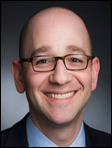
Precision medicine company Cota hires Andrew Norden, MD (IBM Watson Health) as CMO.

Dan Watanapongse (Sterigenics International) joins Intelligent Medical Objects as EVP and CFO.

Kaiser Permanente appoints Harvard Medical School pediatrics professor Mark Schuster, MD head of its new medical school in Pasadena, CA. The school will welcome its first group of students in the fall of 2019.

Bruce Henderson (Navigant) joins consulting firm Navvis as president.
Acquisitions, Funding, Business, and Stock

23andMe raises $250 million in a round led by new investor Sequoia Capital, bringing its total funding to near $500 million and a reported valuation of $1.75 billion.

Healthcare business development company Marketware secures $4.5 million in a Series B round led by Epic Ventures. Alex Obbard (Solutionreach) has joined the company as CEO.
Public and private payer Centene expands in New York via its $3.7 billion acquisition of Fidelis Care.

Dallas-based Tenet Healthcare shares climb 13 percent following a Wall Street Journal report suggesting it is considering a sale of the company. Tenet shares are down 72 percent in the last three years in the face of ongoing activist investor pressures.
Announcements and Implementations
Allscripts and Surescripts offer pharmacists in Alabama, Florida, Georgia, North Carolina, and South Carolina complimentary access to patient medication history data as part of their hurricane relief efforts.
Perficient redesigns the Colorado Center for Personalized Medicine’s data warehouse, moving it from University of Colorado hosting services to Google Cloud.

FormFast debuts its Connect e-forms solution on the Salesforce AppExchange.
Government and Politics

CMS previews the SSN-less Medicare cards it will begin mailing out next April.

Irving Burton Associates signs a two-year, $11 million contract with the US Army Medical Research and Materiel Command to supply research, scientific, management, and technical support services for its Telemedicine and Advanced Technology Research Center.
Privacy and Security
Fortified Health Security partners with IoT security software company ZingBox to develop a program that will help healthcare organizations monitor and manage connected medical devices and networks, as well as potential threats.

Senator Al Franken (D-MN) asks Apple CEO Tim Cook for more details on the upcoming iPhone X’s use of facial recognition to unlock the phone, particularly in the areas of privacy and security. He points out that, “should a bad actor gain access to the faceprint data that Face ID requires, the ramifications could last forever, particularly if Apple’s biometric technology comes to be used in other devices and settings. Furthermore, Apple itself could use the data to benefit other sectors of its business, sell it to third parties for surveillance purposes, or receive law enforcement requests to access its facial recognition system – eventual uses that may not be contemplated by Apple customers.”
Sales

Sutter Health (CA) selects advance care planning software from Vynca.
Christus Continuing Care (TX), Carespring Health Care Management (OH), Cornerstone Healthcare Group (TX), and Perimeter Healthcare (GA) contract with HCS for its Interactant EHR.

Brigham Health (MA) selects Redox’s API services to consolidate and standardize EHR data for use with hospital apps.
Technology

CoverMyMeds will develop e-referral technology for speedier electronic prior authorization of specialty medications.

Epic announces “worldwide interoperability” with the November launch of Share Everywhere, which enables patients to give MyChart data access to any provider with an Internet connection, even those without an EHR. In turn, providers can send progress notes back to the patient’s care team.
Innovation and Research
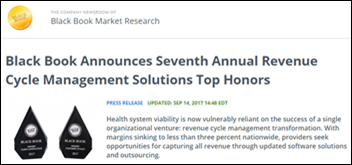
Optum360, Navicure, ZirMed, and Advisory Board take top client experience honors for software and technology in Black Book’s latest RCM survey, which also found that 74 percent of respondents are reprioritizing RCM ahead of projects related to population health, patient engagement, analytics, and physician practice acquisition and recruitment.
Other

San Diego workers spray city streets with bleach in an attempt to stem an outbreak of hepatitis A that has killed 15 and infected 400 people, mostly homeless. City officials have declared a public health emergency, installed hand-washing stations and additional public toilets, launched city-wide vaccination campaigns, and passed out hygiene kits in an effort to keep the outbreak – largely spread by unwashed hands – at bay.

Eight senior citizens die from heat-related distress after The Rehabilitation Center at Hollywood Hills (FL) loses power during Hurricane Irma. Health officials evacuated 141 residents from the facility, sending them to local hospitals and prompting the inspection of other nursing home facilities, of which dozens are still without power.
Sponsor Updates
- Medicity will host its annual client summit September 19-21 in Stone Mountain, GA.
- Dimensional Insight publishes a new white paper, “Three cornerstones for healthcare analytics success.”
- Voalte announces the speaker lineup for the Voalte User Experience conference set to take place October 11-13 in Sarasota, FL.
- Consulting Magazine ranks Impact Advisors fourth on its list of best small firms to work for.
- Over 225 Epic customers adopt National Decision Support Co.’s CareSelect Imaging Platform.
- Dimensional Insight publishes a new resource guide, “How to create a winning business intelligence RFP.”
- Allscripts certifies Elsevier’s Interactive Patient Education as part of its developer program.
- Liaison Technologies begins accepting applications for its Data-Inspired Future Scholarship program.
- LiveProcess will exhibit at California Hospital Association Disaster Planning 2017 September 18-20 in Sacramento, CA.
- MedData will exhibit at the MRCA HFMA Fall Revenue Cycle Conference September 20-22 in Mt. Pleasant, MI.
- Meditech will exhibit at the Wyoming Hospital Association Annual Meeting & Convention September 19-21 in Sheridan.
- Clinical Computer Systems, developer of the Obix Perinatal Data System, will exhibit at the NC/SC Perinatal Partnership Conference September 17-19 in Concord, NC.
- Experian Health will exhibit at the HFMA VA-DC event September 20-22 in Virginia Beach.
- PatientKeeper will exhibit at the MUSE Community Peer Group – Ontario September 15 in Barrie, Ontario.
- Liaison Technologies achieves Payment Card Industry Data Security Standard v3.2 certification and is included in the Visa Global Registry of Service Providers.
- Black Book launches a redesigned website.
- Nordic releases a new podcast, “Using the longitudinal plan of care to drive better outcomes.”
- ZappRx will exhibit at the National Association of Specialty Pharmacy meeting and conference September 18-20 in Washington, DC.
Blog Posts
Contacts
Mr. H, Lorre, Jenn, Dr. Jayne, Lt. Dan.
Get HIStalk updates. Send news or rumors.
Contact us.




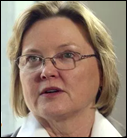
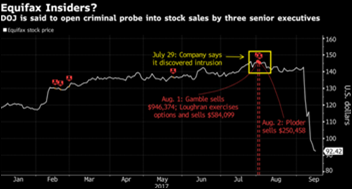


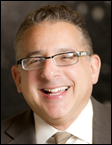








































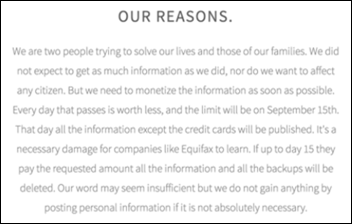






























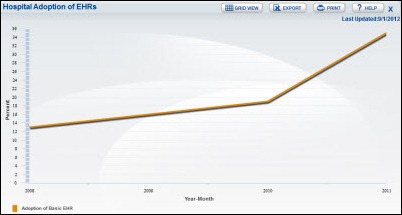
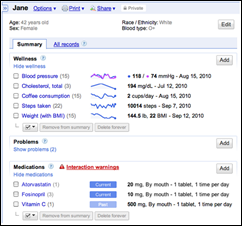







"A valid concern..." Oh please. Everyone picks the software they like and the origin of that software is an afterthought.…